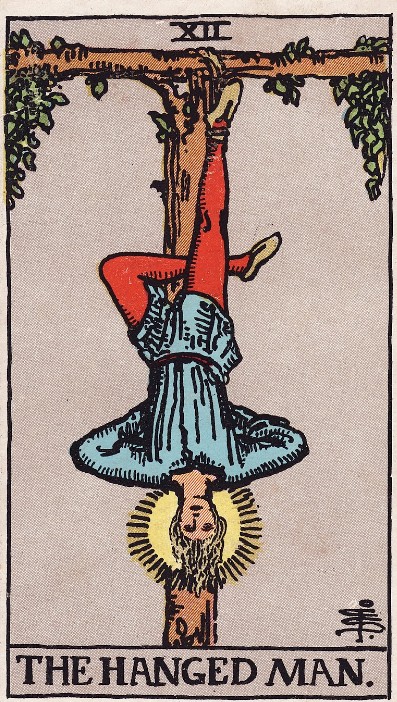
The previous card, justice, lifted the veil and the fool walked through.
Now the path gets tricky.
Today’s card is number 12, the hanged man, and the fool is shocked to come across a gallows scene in a sheltered woodland glade. But he’s more than halfway through the cards and learned not to jump to conclusions or take what he sees at face value.
There’s been progress.

The card suggests a reversal of the usual upright stance, a defiance of natural gravity. The world is being seen in a different way.
The structure from which he’s suspended is alive with buds and leaves. Despite his upside down appearance, or turn in the natural order, the hanged man’s feet are attached to a living tree.
He remains rooted in life. This is no death sentence or punishment; it’s more of a temporary pause.
But why a tree?
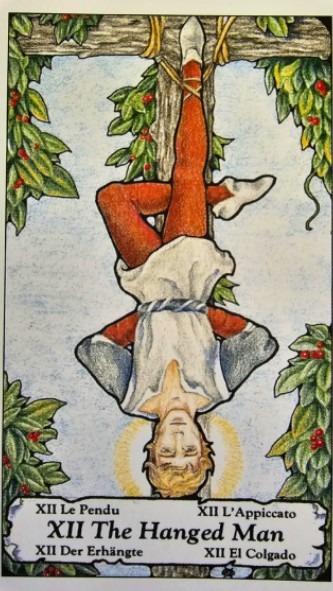
The tree has long been a symbol of life – hence the tree of life found in multiple belief systems.
Christianity has one in the Garden of Eden. In Islam there’s the Tree of Immortality. Buddhism has the Bodhi tree and in Hinduism it’s a Banyan tree. The 10 Sefirot, or powers in the divine realm, are interconnected paths on the Jewish Kabbalah’s tree of life.
Why is the man hanging upside down?
While connections between trees and spirituality go back a long way, the hanged man also has multiple origins. Many tarot enthusiasts believe card 12 links to the world tree Yggdrasil in Norse mythology, where Odin hung upside down for 9 days and nights to obtain wisdom.
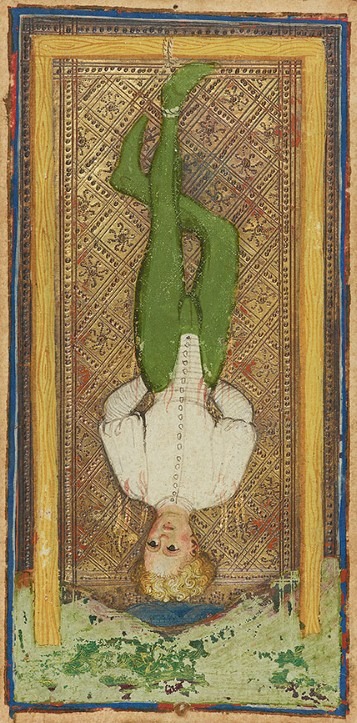
Historically, inverted hanging was used for criminals. To be hung upside down, by a single foot, was a popular method of execution for those named and shamed as traitors.
In some packs, such as the Italian Genovean tarot, the card was called the traitor, while the number 12 has been associated witth Judas, the 12th apostle who betrayed Jesus to the Roman guards.
The hanged man in the Rothschild and Rosenwald decks show him holding bags of money, which may be a reference to the 30 pieces of silver, although they could also show a generic scene of financial corruption.

The earliest tarot show aspects of life in 15th century Italy and the hanged man might well be connected to the practice of shame paintings (pitture infamanti).
In feudal medieval times, shame was also a large part of the code of honour of the aristocracy and armies.
Like the virtues of strength, justice and temperance, the threat of being shamed helped maintain social order.

Public disgrace and humiliation were used as punishment, like putting someone in the stocks and pelting them with rubbish.
Shame was a form of social control so if an accused person escaped and left town, an image was often drawn on a prominent city building so all would know of their alleged crimes.
The pope supported this practice, as did the Visconti and Sforza families who between them commissioned the earliest tarot images, so it’s not unlikely that the first hanged man cards reflected this practice.
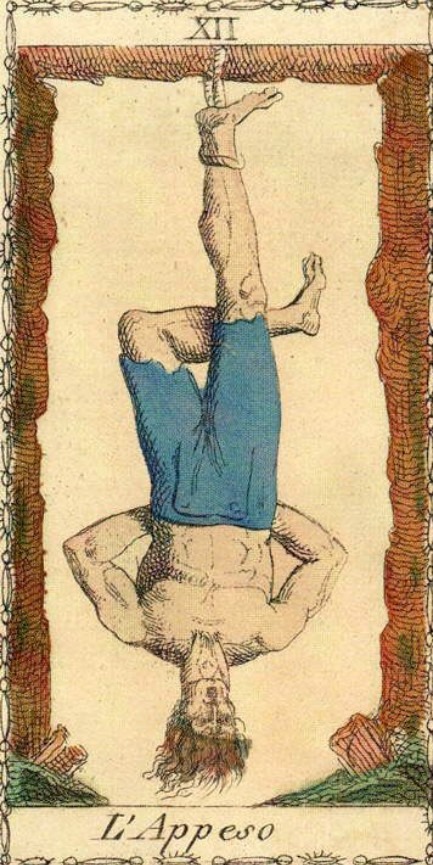
The fool knows that feeling shame can cause guilt, and the second line of cards are introducing him to his unconscious self, the place where unwanted and unpleasant thoughts and emotions are often repressed.
To achieve individuation or wholeness, the fool must explore this unconscious layer in order to fully understand himself and his place in the world.

In the Giuseppe Mitelli tarot from the mid 17th century and named after its engraver, the traitor is a man convicted of murder and depicted being hammered rather than hung.
The Vandenborre and Jacques Vievel tarots show the hanged man turned upright but apart from these exceptions, the hanged man design has hardly changed.

When the tarot was adopted by the Frech occultists, the hanged man represented surrender of the unseen power of god.
Antoine Court de Gébelin suggested the hanged man represented prudence.

Eliphas Levi linked him to both Judas and Prometheus while Etteilla saw the card as an individual reaching a turning point in their lives.
This was followed by Oswald Wirth in the 19th century who used the image to represent transcendence.
The hanged man has let go of the past and sees the world differently.

From this point forward his soul has become free and his future life will focus on non-material thoughts and experiences.
The coins falling from the money bags were now spiritual knowledge and the gibbet had two upright trunks which mirrored the pillars in the high priestess, hierophant and justice.
The occultists also introduced the concept of a divine law which could be followed or denied.
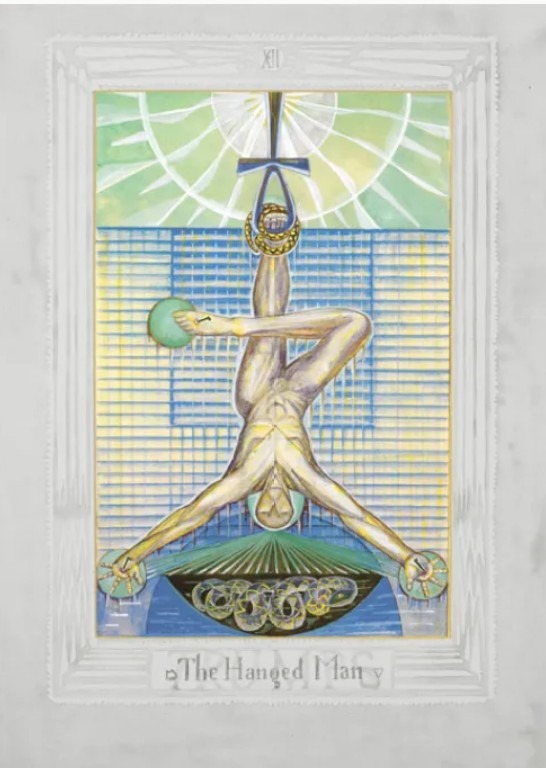
The Waite/Coleman Smith tarot reinforced the concept of alchemical symbolism whereby the body is shaped like an inverted triangle topped by a cross.
The work of the alchemists was to discover the philosopher’s stone which symbolised integration and enlightenment.
This represented accomplishment of the ‘great work’ or magnum opus, both a Hermetic and Thelemic reference to a spiritual path leading to transcendence.

Waite saw the card as an example of Christian mysticism where the universe was created by divine forces.
The hanged man is in a state of suspension.
He’s learned to release the drivers of desire, which can then be transformed into spiritual energy.
The fool has met a few difficult cards, but none so complex as this one.

He is now on the other side of the veil behind justice, but despite the card appearing bizarre and unexpected, there’s a simplicity about it which appeals to him. The wheel of fortune emphasised the ups and downs of life and the fool feels here is someone who understands how to deal with the unpredictable.
The hanged man appears calm and unbothered by his situation.
Somewhere beyond the trials and tribulations of life, he’s found inner peace.
Why the man is suspended and for whatever purpose, the fool likes this sense of tranquillity. He looks, watches, and realises this might be his time to learn surrender.

Where can he start?The hanged man should be interpreted symbolically rather than literally.
The current path through line 2, the unconscious, has been encouraging the fool to look inwards for answers but the hanged man still requires action.
The fool must let go of what he can’t change.
Instead of battling with the unchangeable, he needs to focus instead on how he responds.

Few people want to witness the darker aspects of life such as war, destruction, and cruelty, but too often there’s a lack of practical steps we can take to stop it happening.
The psychological effects of our past life can’t be changed, but it’s always possible to explore the damage and find tools to help recovery.
The hanged man represents acceptance of spiritual awakening. Every card the fool has met on his walk through the tarot has been leading him to this moment. He’s learning to deconstruct the world he lives in. It’s time t begin the long inner process of finding himself.

It’s not been easy and the hanged man calls for the fool to stop a while.
The card is not asking him to fully understand every single detail on the previous cards, but it does signify acceptance.
This might well mean remaining different to the crowd and turning away from social and cultural expectations. The fool needs to discover new ways to be himself while retaining the love of those who care for him, but don’t follow his new path.
He’s learning to find himself and the hanged man represents the experience of instinctively knowing how the right choices feel.

The card is strength made manifest. The hermit has shown the fool he needs to withdraw in order to seek knowledge which can only be found on the inside. Either through solo meditation and mindfulness, or finding a group of like minded people whose texts and beliefs feel right for him.
The hanged man is the outcome of the hermit‘s teaching. It shows the fool a genuine experience of being the still point in the turning wheel of fortune.
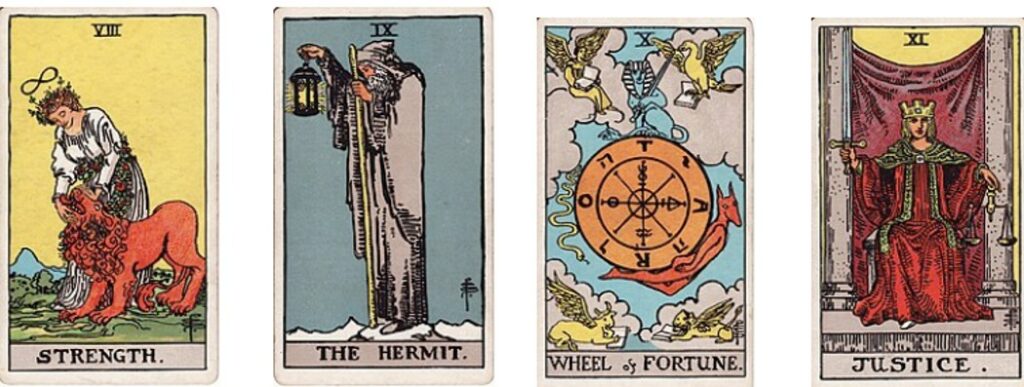
While others may feel pushed and pulled by external events, the fool has stepped through the veil behind justice and found the potential for balance.
The hanged man offers the opportunity he needs to pause and reflect on all he’s learned so far.

As well as changing how he sees the world, the fool also needs to accept others will have world views that feel right for them, even if he doesn’t agree with their outlooks or behaviours.
When his walk through the tarot has ended, he might well return to the people he once knew. He’ll be excited and want others to discover the journey for themselves, especially if he can see they’re having problems coping with their own lives.
Everyone has their own path. So long as it harms no one, the fool must let them continue, rather than persuade them to follow his own footsteps and become a proselytizer.
What works for him will be unique and personal.

The hanged man is showing it’s possible to be content with being different. The more the fool experiences the hanged man’s inner peace, the more it will give him the additional strength to face the cards to come.
There are two more cards on this line of the unconscious self, then it’s time to face the third row, where he’ll need to dig deep into his subconscious. Some of these cards will be harder than anything he’s experienced so far, but step by step, his knowledge and resilience is growing.
The next card the fool will meet is death. His initial reaction will be fear but like the other cards in the tarot’s major arcana, all will not be as it first might appear.
Join us on the next step of this walk through the tarot.
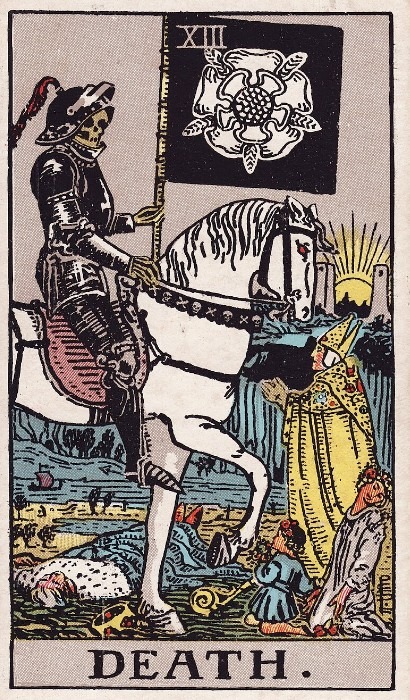
images my own, copyright free from wikipedia commons or from https://pixabay.com/